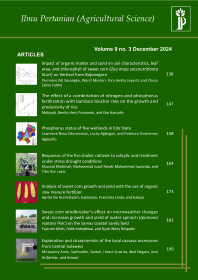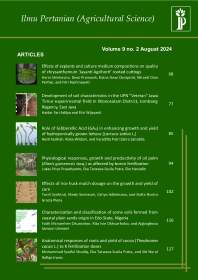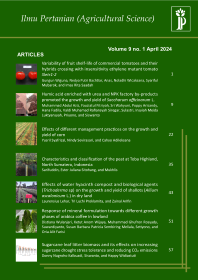
The improvement of microclimate and soil characteristics in cocoa-tree agroforestry patterns
Ramces Sitohang(1*), Eka Tarwaca Susila Putra(2), Cahyo Wulandari(3)
(1) Department of Agronomy, Faculty of Agriculture, Universitas Gadjah Mada Jln. Flora no. 1, Bulaksumur, Sleman, Yogyakarta 55281, Indonesia
(2) Department of Agronomy, Faculty of Agriculture, Universitas Gadjah Mada Jln. Flora no. 1, Bulaksumur, Sleman, Yogyakarta 55281, Indonesia
(3) Department of Soil Science, Faculty of Agriculture, Universitas Gadjah Mada Jln. Flora no. 1, Bulaksumur, Sleman, Yogyakarta 55281, Indonesia
(*) Corresponding Author
Abstract
Shade trees are used in agroforestry pattern for production and service aspects. Cocoa-tree agroforestry pattern is expected to improve atmospheric and rhizosphere zone in cacao plantations. However, the information related to this is still quite limited. This study was conducted using a nested design, with types of shade trees as nest. Shade trees used were Falcataria moluccana, Cocos nucifera, and Cassia spectabilis, and without shade was used as control. Variables observed were light, air temperature, humidity, soil temperature, soil texture, bulk density, permeability, and moisture content. Soil chemical properties were also observed, including organic C, pH, total N, P, K, Ca, Mg, B and content of available P, K, Ca, Mg, and B. The results showed that cacao agroforestry pattern using F. moluccana and C. spectabilis was able to improve the microclimate characteristics and soil fertility. However, F. moluccana showed lower soil fertility than C. spectabilis. F. moluccana and C. spectabilis shade trees were able to optimize light plants from 33 % to 34 %, and from 38 % to 39 %, respectively. F. moluccana could provide optimal air and soil temperature of 30 ⁰C to 32 ⁰C and 27 ⁰C, respectively. Meanwhile, C. spectabilis could provide optimal air and soil temperature of 29 ⁰C to 31⁰C and 26 ⁰C to 27 ⁰C, consecutively. Cocoa-tree agroforestry pattern using C. Spectabilis shade trees could optimize soil moisture content, pH, total N, and P, and availabilities of K, Ca, Mg, and B in soil.
Keywords
Full Text:
PDFReferences
Abou-Rajab, Y., Leuschner, C., Barus, H., Tjoa, A., and Hertel, D. (2016). Cacao cultivation under diverse shade cover allows high carbon storage and sequestration without yield losses. PLoS ONE 11(2), pp. 1–22.
Armengot, L., Barbieri, P., Andres, C., Milz, J., and Schneider, M. (2016). Cacao agroforestry system have higher return on labor compared to full-sun monoculture. Agronomy for Sustainable Development. pp. 36-70.
Apichatmeta, K., Sudsiri, J. C., and Ritchie, J. R. (2017). Photosynthesis of oil palm (Elaeis guineensis). Scientia Horticulturae, 214, pp. 34–40.
Asigbaase, M. Dawoe, E., Sjogersten, S., and Lomax, H. B. (2021). Decomposition and nutrient mineralisation of leaf litter in smallholder cocoa agroforests: a comparison of organic and conventional farms in Ghana. Journal of Soils and Sediments, 21(2), pp. 1010–1023.
Bachtiar, B. (2017). Pengaruh tegakan lamtoro gung Leucaena leucocephala L. terhadap kesuburan tanah di Kawasan Hutan Ko’mara Kabupaten Takalar. Jurnal Ilmu Alam dan Lingkungan, 8(15), pp. 1–6.
Beer, J. Muschler, R., Kass, D., and Somarriba, E. (1998). Shade management in coffee and cacao plantations. Agroforestry systems, 38(1), pp. 139–164.
Brito-Vega, H., Salaya-Dominguez, J. M. Gomez-Mendez, E., Gomez-Vazquez, A., and Antele-Gomez, J. B. (2018). Physico-chemical properties of soil and pods (Theobroma cacao L.) in cocoa agroforestry systems. Journal of Agronomy, 17(1), pp. 48–55.
Erwiyono, R. (2007). Penetapan penyebab kerusakan pertanaman kakao akibat musim kemarau. Warta Pusat Penelitian Kopi dan Kakao Indonesia, 23(3), pp. 131–141.
Hartemink, A. E. (2005). Nutrient stocks, nutrient cycling, and soil changes in cocoa ecosystems: A review. Advances in Agronomy, 86, pp. 227–253.
Hu, E., Tong, L., Hu, D., and Liu, H. (2011). Mixed effects of CO2 concentration on photosynthesis of lettuce in a closed artificial ecosystem. Ecological Engineering, 37(12), pp. 2082–2086.
Jung, D. H., Kim. D., Yoon, H. I., Moon, T. W., Park, K. S., and Son, J. E. (2016) Modeling the canopy photosynthetic rate of romaine lettuce (Lactuca sativa L.) grown in a plant factory at varying CO2 concentrations and growth stages. Horticulture Environment and Biotechnology, 57(5), pp. 487–492.
Kohler, M., Dierick, D., Schwendenmann, L., and Ho lscher, D. (2009) Water use characteristics of cacao and Gliricidia trees in an agroforest in Central Sulawesi, Indonesia. Ecohydrology, 2, pp. 520–529.
Lahive, F., Hadley, P., and Daymond, A. J. (2018). The impact of elevated CO2 and water deficit stress on growth and photosynthesis of juvenile cacao (Theobroma cacao L.). Photosynthetica, 56(3), pp. 911–920.
Mortimer, R., Saj, S. and David, C. (2018). Supporting and regulating ecosystem services in cacao agroforestry systems. Agroforestry Systems, 92(6), pp. 1639–1657.
Partey, S. T., Thevathasan, N. V., Zoumore, R. B., and Preziosi, R. F. (2018). Improving maize production through nitrogen supply from ten rarely-used organic resources in Ghana. Agroforestry Systems, 92(2), pp. 375–387.
Riwandi, Prasetyo, Hasanudin, and Cahyadinata, I. (2017). Kesuburan tanah dan pemupukan. Bengkulu: Sahabat Alam Rafflesia, pp. 95.
Rubiyo, R., and Siswanto, S. (2012). Increased production and development of cocoa (Theobroma cacao L.) in Indonesia. Journal of Industrial and Freshening Plants, 3(1), pp. 33–48.
Sari, M. N., Sudarsono, and Darmawan. (2017). Effect of organic matter on phosphorus availability in soils rich of Al and Fe. Buletin Tanah dan Lahan. 1(1), pp. 65–71.
Tscharntke, T. Clough, Y., Bhagwat, SA., Buchori, D., Faust, H., Hertel, D., Ho ̈lscher, D., Juhrbandt, J., Kessler, M, Perfecto, I., Scherber, C., Schroth, G., Veldkamp, E., and Wanger, T.C. (2011). Multifunctional shade-tree management in tropical agroforestry landscapes—a review. Journal of Applied Ecology, 48 (3), pp. 619–629.
Zaia, F.C., Gama-Rodrigues, A.C., Gama-Rodrigues, E.F., da Silva Moco, M.K., Fontes, A.G., Machado, R.C.R., and Baligar, V.C. (2012) Carbon, nitrogen, organic phosphorus, microbial biomass and N mineralization in soils under cacao agroforestry systems in Bahia, Brazil. Agroforestry System 86(2), pp. 197–212.
Article Metrics
Refbacks
- There are currently no refbacks.
Ilmu Pertanian (Agricultural Science) ISSN 0126-4214 (print), ISSN 2527-7162 (online) is published by Faculty of Agriculture Universitas Gadjah Mada collaboration with Perhimpunan Sarjana Pertanian Indonesia (PISPI) and licensed under a Creative Commons Attribution-ShareAlike 4.0 International License.














